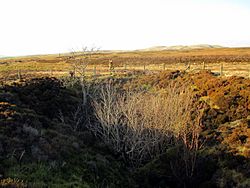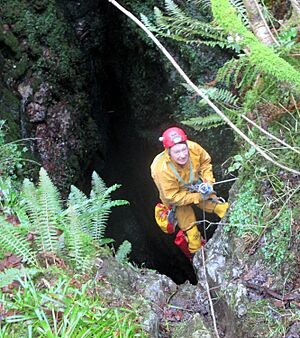Death's Head Hole facts for kids
Quick facts for kids Death's Head Hole |
|
|---|---|

Entrance of Death's Head Hole
|
|
| Location | Leck Fell, Lancashire, England |
| OS grid | SD 6678 7916 |
| Depth | 120 metres (390 ft) |
| Length | 567 metres (1,860 ft) |
| Elevation | 335 metres (1,099 ft) |
| Discovery | 1889 |
| Geology | Carboniferous limestone |
| Entrances | 3 |
| Hazards | verticality |
| Access | Unrestricted |
| Cave survey | cavemaps |
Death's Head Hole is a cool cave found on Leck Fell in Lancashire, England. It's known for its super deep entrance, which is like a big hole going down 64 metres (210 ft). This cave is connected to another one called Lost John's Cave. Together, they are part of a huge underground network. This network is called the Three Counties System. It's an amazing 87-kilometre (54 mi) long! This giant cave system stretches across Cumbria, Lancashire, and North Yorkshire.
Contents
Exploring Death's Head Hole
The main entrance to Death's Head Hole is a deep shaft. It's fenced off for safety. This shaft drops about 64 metres (210 ft) down. At the bottom, you land on a slope of loose rocks. From there, you go down another 6 metres (20 ft) drop. This leads you into the Main Chamber.
Inside the Main Chamber
The Main Chamber is a really big room underground. A waterfall pours into it from one side. In a corner of this chamber, there's a 10-metre (33 ft) deep shaft. This shaft has scaffolding to help you get down. It quickly leads into a stream passage. This passage is about 100 metres (330 ft) long. It ends at a 4-metre (13 ft) waterfall. This waterfall drops into the main stream of Lost Johns' Cave. This spot is about 200 metres (660 ft) from the very end of Lost Johns' Cave.
East Passage and Dolphin Passage
You can climb up the waterfall in the Main Chamber. This 23-metre (75 ft) climb takes you into the East Passage. This passage is beautifully decorated with cave formations. A small stream flows through it. After about 150 metres (490 ft), the passage gets lower and muddy. Explorers have climbed up a chimney-like opening in this passage for 43 metres (141 ft).
The stream in East Passage comes from a low crawl. This crawl is called Dolphin Passage. It gets wider as you go. It passes a small tunnel that goes towards Eyeholes. Eyeholes is a blocked-up hole about 50 metres (160 ft) north-east of Death's Head Hole's entrance. Dolphin Passage then becomes very wet. Explorers have pushed through this wet part. They found it connects to the bottom of Long Drop Cave. This is where the water in Dolphin Passage comes from.
Big Meanie: Another Entrance
Big Meanie is another way to get into this cave system. It's also known as Hawthorn Pot or Nostril Pot. You can find it about 100 metres (330 ft) west of Death's Head Hole. It's in a sunken area next to a wall. A narrow crack leads straight down a 49-metre (161 ft) drop. This drop lands you in a tall, narrow passage.
If you go west in this passage, it ends in a large room. This room is blocked by mud. If you go east, the passage splits. One path goes towards Eyeholes but gets too tight. The other path goes through a narrow, dug-out spot. This leads to a muddy crawl. It ends on a ledge 21 metres (69 ft) above the floor of the Death's Head Main Chamber. This ledge is right across from the East Passage.
How the Cave Formed
Death's Head Hole is a solutional cave. This means it was formed by water dissolving rock. The rock here is called Great Scar limestone. This limestone formed during the Carboniferous period. The cave's shape was greatly affected by a large crack in the rock. This crack is called a fault. It's the same fault found in nearby Rumbling Hole and Big Meanie.
The stream flowing through Death's Head Hole starts in Long Drop Cave. It then flows into Lost Johns' Cave. It joins other streams there. Eventually, all this water comes out at a spring called Leck Beck Head. This spring is in Ease Gill. Scientists think the main part of the cave we see today is quite new. About 350,000 years ago, water from Rumbling Hole flowed differently. It went along the fault. It entered Death's Head Hole at the end of East Passage. Then it flowed across what is now the Main Chamber. From there, it went into the passages below Big Meanie. This water then flowed through a now-blocked passage to Glasfurds Chamber. This chamber is in Gavel Pot. Finally, it came out at a spring in the Leck Beck Valley. This old spring was about 100 metres (330 ft) higher than the current one. It is now covered by ancient glacier deposits.
History of Exploration
People have known about Death's Head Hole for a long time. In 1881, a person named Balderstone wrote about the entrance shaft. He described it in detail in his book Ingleton - Bygone and Present. He measured its depth at 200 feet (61 m).
He wrote that the cave entrance looked like a human skull. The main shaft was like the mouth. Two rock bridges inside looked like eye sockets. He thought it was a very curious and fine sight.
The first time anyone went down the cave was in 1889. This was done by the Yorkshire Ramblers' Club. They reached the bottom of the Main Chamber. They also noticed the stream flowing in from the east. In 1892, a local writer mistakenly called the cave "Hell Hole." He also wrongly reported that no one had ever reached the true bottom.
The connection to Lost Johns' Cave was found much later. The Yorkshire Ramblers first saw the inlet passage in Lost Johns' Cave in 1928. But they thought the water came from Gavel Pot. The actual connection between Death's Head Hole and Lost Johns' Cave was finally opened up in 2011. A team from different caving clubs worked together to do this.
The waterfall in the Main Chamber was climbed in 1949. Members of the Gritstone Club did this. They then explored East Passage and Dolphin Passage. This is the passage where water comes from Long Drop Cave. The connection to Long Drop Cave itself was made in 1981. The Gritstone Club managed to get through a short, waterlogged section by bailing out the water.
The entrance to Big Meanie was dug open in 1971. This was done by the Manchester University Speleological Society (MUSS). The connection between Big Meanie and Death's Head Hole was also made in the same year. A joint team from MUSS, Happy Wanderers Cave and Pothole Club, and Northern Cave Club dug through some rocks to open it up.


